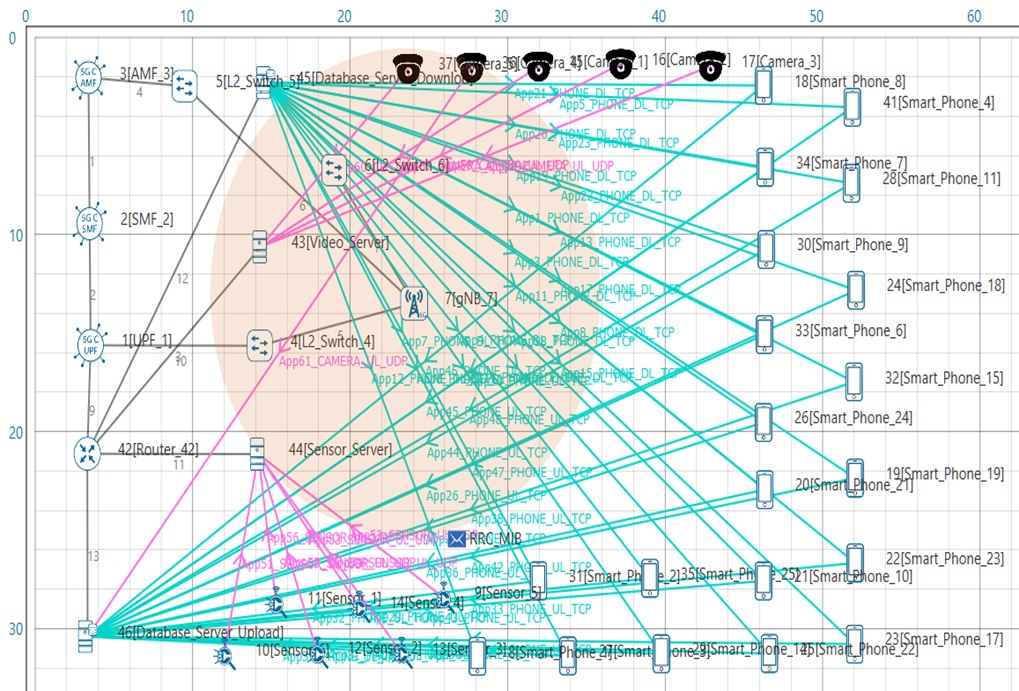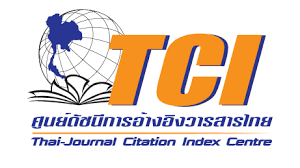Enhancing 5G Data Transmission Through Sub-Carrier Spacing Optimization
Keywords:
5G, Subcarrier Spacing, Numerology, Throughput, Delay, JitterAbstract
5G networks can support various UDP and TCP applications. Efficient and reliable 5G network performance offers faster speeds, improved connectivity, and the capability to manage multiple applications across different locations. This study comprehensively analyses the effect of various subcarrier spacing (SCS) scenarios of 5G networks on the performance of smartphones, cameras, and sensors. The analysis shows that higher SCS values are associated with increased average throughput. It indicates that higher subcarrier spacing values enable more efficient data transmission. Smartphones have low and symmetrical jitter with numerology values of 3 and 2, making them well-suited for bidirectional communication. In comparison, cameras are more efficient than sensors at delivering data with a lower delay at all SCS values, which is crucial for applications requiring fast response times. We propose an adaptive Q-learning-based algorithm that automatically adjusts (SCS) configurations based on real-time network conditions and application needs. This approach significantly enhances network performance across various scenarios. The findings of this study have significant implications for the design and implementation of 5 G networks, as they provide insights into the optimal SCS settings for applications with specific requirements and priorities, thereby guiding network engineers and professionals in their decision-making process.
References
S. Li, T. Xiang, D. Huang, L. Han, Q. Wu, and D. Kong, "An Efficient Random Access Reception Algorithm for ToA Estimation in NB-IoT", Electronics, vol. 12, no. 12, p. 2636, 2023. DOI: 10.3390/electronics12122636
R. Poorzare and O. P. Waldhorst, "Toward the Implementation of MPTCP Over mmWave 5G and Beyond: Analysis, Challenges, and Solutions", IEEE Access, vol. 11, pp. 19534-19566, 2023. doi: 10.1109/access.2023.3248953
P. Wang, Y. Li, Y. Lin, M. Shirvanimoghaddam, O. S. Park, G. Park, and B. Vucetic, "Analysis of Rateless Multiple Access Scheme with Maximum Likelihood Decoding in an AWGN Channel", IEEE Trans-actions on Wireless Communications, 2023. doi: 10.1109/twc.2022.3232781
F. Boccardi, R. W. Heath, A. Lozano, T. Marzetta, and P. Popovski, "Five disruptive technology directions for 5G", IEEE Communications Magazine, vol. 52, no. 2, pp. 74-80, 2014. doi: 10.1109/mcom.2014.6736746
Y. Liu, Z. Qin, M. Elkashlan, Z. Ding, A. Nallanathan, and L. Hanzo, "Non-Orthogonal Multiple Access for 5G and Beyond", IEEE Com-munications Magazine, vol. 55, no. 2, pp. 210-217, 2017. doi: 10.1109/jproc.2017.2768666
E. Dahlman, S. Parkvall, and J. Skold, “5G NR: The next generation wireless access technology", Academic Press, 2020. doi: 10.1016/b978-0-12-814323-0.00005-3
E. Dahlman, S. Parkvall, and J. Skold, “5G NR: The next generation wireless access technology”, Academic Press, 2018. doi: 10.1016/b978-0-12-814323-0.00005-3
M. Abd-Elnaby, G. G. Sedhom, E. S. M. El-Rabaie, and M. El-wekeil, "NOMA for 5G and beyond: literature review and novel trends", Wireless Networks, vol. 29, no. 4, pp. 1629-1653, 2023. doi: 10.1007/s11276-022-03175-7
M. Raftopoulou and R. Litjens, "Optimization of numerology and packet scheduling in 5G networks: To slice or not to slice?," 2021 IEEE 93rd Vehicular Technology Conference (VTC2021-Spring), 2021, pp. 1-5.
doi: 10.1109/VTC2021-Spring51267.2021.9448814
A. Yazar and H. Arslan, "Reliability enhancement in mul-ti-numerology-based 5G new radio using INI-aware scheduling," EURASIP Journal on Wireless Communications and Networking, vol. 2019, no. 1, pp. 1-14, 2019. doi: 10.1186/s13638-019-1435-z
Soni, Tapisha, Ali, A. R., Ganesan, K., & Schellmann, M,"Adaptive numerology—A solution to address the demanding QoS in 5G-V2X", IEEE Wireless Communications and Networking Conference (WCNC). IEEE, 2018. doi: 10.1109/WCNC.2018.8377205
Correia, N., Al-Tam, F., & Rodriguez, J. “Optimization of mixed nu-merology profiles for 5G wireless communication scenarios.”, Sensors, 21(4), 1494.2021 doi: 10.3390/s21041494
X. Gao, L. Dai, S. Han, I. Chih‐Lin, & R. Heath, "Energy-efficient hybrid analog and digital precoding for mmwave mimo systems with large antenna arrays", IEEE Journal on Selected Areas in Communi-cations, vol. 34, no. 4, p. 998-1009, 2016. doi: 10.1109/jsac.2016.2549418
T. Kebede, Y. Wondie, J. Steinbrunn, H. Belay, & K. Kornegay, "Pre-coding and beamforming techniques in mmwave-massive mimo: performance assessment", IEEE Access, vol. 10, p. 16365-16387, 2022. doi: 10.1109/access.2022.3149301
C. Fischione, D. Koutsonikolas, S. Rangan, J. Widmer, X. Zhang, & A. Zhou, "Guest editorial millimeter-wave networking", IEEE Journal on Selected Areas in Communications, vol. 37, no. 12, p. 2649-2652, 2019. doi: 10.1109/jsac.2019.2947996
J. Yang, S. Jin, Y. Han, M. Matthaiou, & Y. Zhu, "3-d position and velocity estimation in 5g mmwave cran with lens antenna arrays", IEEE xplore, 2019. doi: 10.1109/vtcfall.2019.8891333
A. Shallah, F. Zubir, M. Rahim, H. Majid, U. Sheikh, N. Muradet al., "Recent developments of butler matrix from components design evolution to system integration for 5g beamforming applications: a survey", IEEE Access, vol. 10, p. 88434-88456, 2022. doi: 10.1109/access.2022.3199739
J. Lota, S. Sun, T. Rappaport, & A. Demosthenous, "5g uniform linear arrays with beamforming and spatial multiplexing at 28, 37, 64, and 71 ghz for outdoor urban communication: a two-level approach", IEEE Transactions on Vehicular Technology, vol. 66, no. 11, p. 9972-9985, 2017. doi: 10.1109/tvt.2017.2741260
L. Mendes, J. Vaz, F. Passos, N. Lourenço, & R. Martins, "In-depth design space exploration of 26.5-to-29.5-ghz 65-nm cmos low-noise amplifiers for low-footprint-and-power 5g communications using one-and- two -step design optimization", IEEE Access, vol. 9, p. 70353-70368, 2021. doi: 10.1109/access.2021.3078240
Z. Yuan, T. Azzino, H. Yu, Y. Lyu, H. Pei, A. Boldiniet al., "Net-work-aware 5g edge computing for object detection: augmenting wearables to “see” more, farther and faster", IEEE Access, vol. 10, p. 29612-29632, 2022. doi: 10.1109/access.2022.3157876
Y. Huo, F. Lu, F. Wu, & X. Dong, "Multi-beam multi-stream commu-nications for 5g and beyond mobile user equipment and uav proof of concept designs", IEEE 90th Vehicular Technology Conference, 2019. doi: 10.1109/vtcfall.2019.8891154
G. Arya, A. Bagwari, and D. S. Chauhan, "Performance analysis of deep learning-based routing protocol for an efficient data transmis-sion in 5G WSN communication", in IEEE Access, vol. 10, pp. 9340-9356, 2022. doi: 10.1109/access.2022.3142082
B. Shilpa, A. K. Budati, L. K. Rao, and S. B. Goyal, "Deep learning based optimized data transmission over 5G networks with Lagrangian encoder", Computers and Electrical Engineering, vol. 102, p. 108164, 2022. doi: 10.1016/j.compeleceng.2022.108164
R. Ford, M. Zhang, M. Mezzavilla, S. Dutta, S. Rangan, and M. Zorzi, "Achieving ultra-low latency in 5G millimeter wave cellular networks", IEEE Communications Magazine, vol. 55, no. 3, pp. 196-203, 2017.
doi: 10.1109/mcom.2017.1600407cm
J. García-Morales, M. C. Lucas-Están, and J. Gozálvez, "Laten-cy-sensitive 5G RAN slicing for industry 4.0", IEEE Access, vol. 7, pp. 143139-143159, 2019. doi: 10.1109/access.2019.2944719
A. Hazarika and M. Rahmati, "Towards an evolved immersive expe-rience: Exploring 5G-and beyond-enabled ultralow-latency commu-nications for augmented and virtual reality", Sensors, vol. 23, no. 7, p. 3682, 2023. doi: 10.3390/s23073682
G. Singh, S. Kumar, A. Abrol, B. K. Kanaujia, V. K. Pandey, M. Marey, and H. Mostafa, "Frequency reconfigurable quad-element MIMO antenna with improved isolation for 5G systems", Electronics, vol. 12, no. 4, p. 796, 2023. doi: 10.3390/electronics12040796
O. P. Naser, H. G. Heba, H. M. Karim, H. S. Chan, R. A. A. A. Raed, N. M. A. Norah, "An efficient antenna system with improved radia-tion for multi-standard/multi-mode 5G cellular communications", Sci. Rep., vol. 13, p. 4179, 2023. doi: 10.1038/s41598-023-31407-z
A. S. Alqahtani, S. B. Changalasetty, P. Parthasarathy, L. S. Thota, and A. Mubarakali, "Effective spectrum sensing using cognitive radios in 5G and wireless body area networks", Computers and Electrical Engineering, vol. 105, 2023. doi: 10.1016/j.compeleceng.2022.108493
S. Y. Huang, H. H. Cho, Y. C. Chang, J. Y. Yuan, and H. C. Chao, "An efficient spectrum scheduling mechanism using Markov decision chain for 5G mobile network", IET Communications, vol. 16, no. 11, pp. 1268-1278, 2022. doi: 10.1049/cmu2.12263
S. Grishma and S. Tappari, "Performance Analysis of 5G Waveforms for MIMO System," Fifth International Conference on Electrical, Computer and Communication Technologies (ICECCT), pp. 1-6.,2023 doi: 10.1109/icecct56650.2023.10179661
D. Anand, M. A. Togou, and G. M. Muntean, "A machine learning solution for video delivery to mitigate co-tier interference in 5G Het-Nets", IEEE Transactions on Multimedia, 2022. doi: 10.1109/tmm.2022.3187607
C. Liu, Y. Xie, H. Li, Y. Wang, and Y. Zhang, "A Framework for As-sessing the Resilience of 5G Mobile Communication Networks," IEEE International Conference on Artificial Intelligence and Computer Applications (ICAICA), 2022, pp. 1077-1081. doi: 10.1109/icaica54878.2022.9844485
R. Li, B. Decocq, A. Barros, Y. P. Fang, and Z. Zeng, "Estimating 5G network service resilience against short timescale traffic variation", IEEE Transactions on Network and Service Management, 2023.
DOI: 10.1109/tnsm.2023.3269673
S. Kaada, M. L. A. Morel, G. Rubino, and S. Jelassi, "Measuring 5G-RAN Resilience Using Coverage and Quality of Service Indica-tors," IEEE/IFIP Network Operations and Management Symposium, 2023, pp. 1-7. doi: 10.1109/noms56928.2023.10154368
A. K. Sangaiah, A. Javadpour, P. Pinto, F. Ja’fari, and W. Zhang, "Improving quality of service in 5G resilient communication with the cellular structure of smartphones", ACM Transactions on Sensor Networks (TOSN), vol. 18, no. 3, pp. 1-23, 2022. doi: 10.1145/3512890
V. Saravanan, P. Sreelatha, N. R. Atyam, M. Madiajagan, D. Sara-vanan, and H. P. Sultana, "Design of deep learning model for radio resource allocation in 5G for massive IoT device", Sustainable Ener-gy Technologies and Assessments, vol. 56, p. 103054, 2023. doi: 10.1016/j.seta.2023.103054
K. Koutlia, B. Bojovic, S. Lagen, X. Zhang, P. Wang, and J. Liu, "Sys-tem analysis of QoS schedulers for XR traffic in 5G NR", Simulation Modelling Practice and Theory, vol. 125, p. 102745, 2023. doi: 10.1016/j.simpat.2023.102745
Y. Zhang, H. Cao, M. Zhou, and L. Yang, "Spectral efficiency maxi-mization for uplink cell-free massive MIMO-NOMA networks," 2019 IEEE International Conference on Communications Workshops (ICC Workshops), 2019, pp. 1-6. doi: 10.1109/iccw.2019.8756881
S. Kusaladharma, W. P. Zhu, W. Ajib, and G. Amarasuriya, "Achiev-able rate analysis of NOMA in cell-free massive MIMO: A stochastic geometry approach," IEEE International Conference on Communica-tions (ICC), 2019, pp. 1-6. doi: 10.1109/icc.2019.8761506
X. Hong, J. Wang, C. X. Wang, and J. Shi, "Cognitive radio in 5G: a perspective on energy-spectral efficiency trade-off", IEEE Communi-cations Magazine, vol. 52, no. 7, pp. 46-53, 2014. doi: 10.1109/mcom.2014.6852082
J. Wang, A. Jin, D. Shi, L. Wang, H. Shen, D. Wu, et al., "Spectral efficiency improvement with 5G technologies: Results from field tests", IEEE Journal on Selected Areas in Communications, vol. 35, no. 8, pp. 1867-1875, 2017. doi: 10.1109/jsac.2017.2713498
S. M. Islam, M. Zeng, and O. A. Dobre, "NOMA in 5G systems: Ex-citing possibilities for enhancing spectral efficiency," arXiv preprint
doi: 10.48550/arXiv.1706.08215
A. L. Ha, T. H. Nguyen, T. Van, V. D. Nguyen, and W. Choi, "Deep learning-aided 5G channel estimation," 15th International Confer-ence on Ubiquitous Information Management and Communication (IMCOM), pp. 1-7.,2021. doi: 10.1109/imcom51814.2021.9377351
H. A. Le, T. C. Van, T. H. Nguyen, H. Choo, and V. D. Nguyen, "Ma-chine learning-based 5G-and-beyond channel estimation for MIMO-OFDM communication systems", Sensors, vol. 21, no. 14, p. 4861, 2021. doi: 10.3390/s21144861
M. Belgiovine, K. Sankhe, C. Bocanegra, D. Roy, and K. R. Chow-dhury, "Deep learning at the edge for channel estimation in be-yond-5G massive MIMO", IEEE Wireless Communications, vol. 28, no. 2, pp. 19-25, 2021. doi: 10.1109/mwc.001.2000322
T. K. Vu, M. Bennis, S. Samarakoon, M. Debbah, and M. Latva-aho, "Joint Load Balancing and Interference Mitigation in 5G Heteroge-neous Networks", IEEE Transactions on Wireless Communications, vol. 16, no. 9, pp. 6032-6046, 2017. doi: 10.1109/twc.2017.2718504
Y. Wang, G. Feng, Y. Sun, S. Qin, and Y. C. Liang, "Decentralized learning based indoor interference mitigation for 5G-and-beyond sys-tems", IEEE Transactions on Vehicular Technology, vol. 69, no. 10, pp. 12124-12135, 2020. doi: 10.1109/tvt.2020.3012311
3GPP TS 38.211 V15.5.0. Physical channels and modulation.3rd Generation Partnership Project: Technical Specification Group Ra-dio Access Network, 2018
3GPP TS 38.211: V17.1.0. Physical channels and modulation. 3rd Generation Partnership Project: Technical Specification Group Ra-dio Access Network,2022
M. Hijjawi, M. Shinwan, M. Qutqut, W. Alomoush, O. Khashan, M. Alshdaifat, A. Alsokkar, and L. Abualigah, "Improved flat mobile core network architecture for 5G mobile communication systems", International Journal of Data and Network Science, vol. 7, no. 3, pp. 1421-1434, 2023. doi: 10.5267/j.ijdns.2023.3.021
L. Turchet and P. Casari, "Latency and Reliability Analysis of a 5G-Enabled Internet of Musical Things system", IEEE Internet of Things Journal, 2023. doi: 10.1109/jiot.2023.3288818
A. A. El-Saleh, A. A. Abdulraqeb, S. Ibraheem, H. H. Wan, S. H. Mo-hamed, and I. D. Yousef, "Measurement analysis and performance evaluation of mobile broadband cellular networks in a populated city", Alexandria Engineering Journal, vol. 66, pp. 927-946, 2023. doi: 10.1016/j.aej.2022.10.052
S. Lagen, B. Bojovic, K. Koutlia, X. Zhang, P. Wang, and Q. Qu, "QoS Management for XR Traffic in 5G NR: A MultiLayer System View and End-to-End Evaluation", IEEE Communications Magazine, 2023. doi: 10.1109/mcom.015.2200745
A. Sufyan, K. B. Khan, O. A. Khashan, T. Mir, and U. Mir, "From 5G to beyond 5G: A Comprehensive Survey of Wireless Network Evolu-tion, Challenges, and Promising Technologies", Electronics, vol. 12, no. 10, p. 2200, 2023. doi: 10.3390/electronics12102200
S. Alraih, R. Nordin, A. A. Samah, I. Shayea, and N. F. Abdullah, "A Survey on Handover Optimization in Beyond 5G Mobile Networks: Challenges and Solutions", IEEE Access, 2023. doi: 10.1109/access.2023.3284905
L. J. Horner, K. Tutschku, A. Fumagalli, and S. Ramanathan, “Virtual
izing 5G and Beyond 5G Mobile Network", Artech House, 2023.
R. Jayaraman, M. Baskar, S. Annamalai, M. Kumar, A. Mishra, and R. Shrestha, "Effective Resource Allocation Technique to Improve QoS in 5G Wireless Network", Electronics, vol. 12, no. 2, p. 451, 2023.
doi: 10.3390/electronics12020451
Watkins, Christopher JCH, and Peter Dayan. "Q-learning. ", Machine learning 8 , 279-292,1992. doi: 10.1007/BF00992698
Patriciello, Natale. "5G new radio numerologies and their impact on the end-to-end latency.", IEEE 23rd international workshop on computer aided modeling and design of communication links and networks (CAMAD). IEEE, 2018. doi: 10.1109/CAMAD.2018.8514979

Downloads
Published
How to Cite
Issue
Section
License

This work is licensed under a Creative Commons Attribution-NonCommercial-NoDerivatives 4.0 International License.








